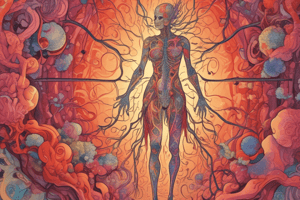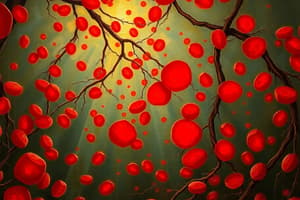Podcast
Questions and Answers
What is the main purpose of inflammation in the body?
What is the main purpose of inflammation in the body?
- To suppress the immune system
- To increase blood flow to the injured area
- To promote tissue healing and repair (correct)
- To cause tissue damage
Which of the following is NOT an example of inflammation involving a specific body part?
Which of the following is NOT an example of inflammation involving a specific body part?
- Appendicitis
- Pneumonia (correct)
- Tonsillitis
- Hepatitis
What type of factors can lead to inflammation?
What type of factors can lead to inflammation?
- Physical factors like heat, cold, and trauma
- Chemical factors like acid and alkali
- Immunological factors
- All of the above (correct)
Which of the following is an infection-related cause of inflammation?
Which of the following is an infection-related cause of inflammation?
What leads to the formation of inflammatory exudate during inflammation?
What leads to the formation of inflammatory exudate during inflammation?
What is the process by which phagocytic cells recognize and engulf foreign particles followed by their degradation?
What is the process by which phagocytic cells recognize and engulf foreign particles followed by their degradation?
What characterizes suppurative inflammation?
What characterizes suppurative inflammation?
What enzyme is responsible for fibrin deposition and localization in suppurative inflammation?
What enzyme is responsible for fibrin deposition and localization in suppurative inflammation?
Which of the following types of inflammation is characterized by multiple communicating subcutaneous abscesses that open in the skin by sinuses?
Which of the following types of inflammation is characterized by multiple communicating subcutaneous abscesses that open in the skin by sinuses?
In what zone of an abscess do we typically find pus during suppurative inflammation?
In what zone of an abscess do we typically find pus during suppurative inflammation?
Which process involves the attraction of neutrophils to the site of infection or injury resulting in pus formation?
Which process involves the attraction of neutrophils to the site of infection or injury resulting in pus formation?
What is the main purpose of acute inflammation?
What is the main purpose of acute inflammation?
Which of the following is a characteristic of chronic inflammation?
Which of the following is a characteristic of chronic inflammation?
What is the consequence of increased permeability in vascular reactions?
What is the consequence of increased permeability in vascular reactions?
Which process involves leukocytes coming peripheral along endothelial cells due to stasis?
Which process involves leukocytes coming peripheral along endothelial cells due to stasis?
What is the primary cellular component involved in acute inflammation?
What is the primary cellular component involved in acute inflammation?
What is the key difference between acute and chronic inflammation in terms of vascular response?
What is the key difference between acute and chronic inflammation in terms of vascular response?
Which term is used to describe a deep abscess with a blind-ended tract connecting it to the skin surface?
Which term is used to describe a deep abscess with a blind-ended tract connecting it to the skin surface?
What is the fate of an abscess if left untreated?
What is the fate of an abscess if left untreated?
Which type of pus is typically associated with cellulitis?
Which type of pus is typically associated with cellulitis?
What is the main difference between a furuncle and a carbuncle?
What is the main difference between a furuncle and a carbuncle?
Which term refers to the spread of infection through the bloodstream?
Which term refers to the spread of infection through the bloodstream?
Which condition is characterized by diffuse suppurative inflammation?
Which condition is characterized by diffuse suppurative inflammation?
Flashcards are hidden until you start studying
Study Notes
Inflammation
- The main purpose of inflammation in the body is to protect it from injury, infection, and foreign substances.
Causes of Inflammation
- Various factors can lead to inflammation, including infection, injury, and foreign substances.
Characteristics of Inflammation
- Suppurative inflammation is characterized by the formation of pus.
- The process of phagocytosis, where phagocytic cells recognize and engulf foreign particles, followed by their degradation, leads to the formation of inflammatory exudate.
- Fibrin deposition and localization in suppurative inflammation are done by the enzyme thrombin.
Types of Inflammation
- Chronic inflammation is characterized by a prolonged inflammatory response.
- Acute inflammation is characterized by the rapid onset of inflammation, which typically resolves once the stimulus is removed.
Abscesses
- An abscess is a localized collection of pus that forms in response to infection.
- Pus is typically found in the center of an abscess during suppurative inflammation.
- If left untreated, an abscess can lead to further complications, such as sepsis.
- A carbuncle is a deep abscess with multiple tracts connecting it to the skin surface.
- Cellulitis is associated with a serous or seropurulent type of pus.
Inflammatory Response
- The primary cellular component involved in acute inflammation is the neutrophil.
- The main difference between acute and chronic inflammation is the vascular response, with acute inflammation characterized by increased blood flow and chronic inflammation characterized by decreased blood flow.
Infection
- The spread of infection through the bloodstream is referred to as sepsis.
- Furuncles are small, superficial abscesses, whereas carbuncles are larger and deeper.
- Diffuse suppurative inflammation is characterized by a widespread inflammatory response.
Studying That Suits You
Use AI to generate personalized quizzes and flashcards to suit your learning preferences.




